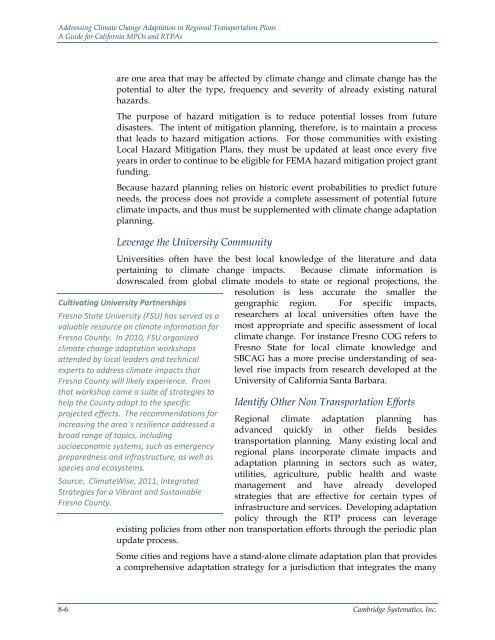addressing climate change adaptation in regional transportation plans
addressing climate change adaptation in regional transportation plans
addressing climate change adaptation in regional transportation plans
Create successful ePaper yourself
Turn your PDF publications into a flip-book with our unique Google optimized e-Paper software.
Address<strong>in</strong>g Climate Change Adaptation <strong>in</strong> Regional Transportation PlansA Guide for California MPOs and RTPAsare one area that may be affected by <strong>climate</strong> <strong>change</strong> and <strong>climate</strong> <strong>change</strong> has thepotential to alter the type, frequency and severity of already exist<strong>in</strong>g naturalhazards.The purpose of hazard mitigation is to reduce potential losses from futuredisasters. The <strong>in</strong>tent of mitigation plann<strong>in</strong>g, therefore, is to ma<strong>in</strong>ta<strong>in</strong> a processthat leads to hazard mitigation actions. For those communities with exist<strong>in</strong>gLocal Hazard Mitigation Plans, they must be updated at least once every fiveyears <strong>in</strong> order to cont<strong>in</strong>ue to be eligible for FEMA hazard mitigation project grantfund<strong>in</strong>g.Because hazard plann<strong>in</strong>g relies on historic event probabilities to predict futureneeds, the process does not provide a complete assessment of potential future<strong>climate</strong> impacts, and thus must be supplemented with <strong>climate</strong> <strong>change</strong> <strong>adaptation</strong>plann<strong>in</strong>g.Leverage the University CommunityUniversities often have the best local knowledge of the literature and dataperta<strong>in</strong><strong>in</strong>g to <strong>climate</strong> <strong>change</strong> impacts. Because <strong>climate</strong> <strong>in</strong>formation isdownscaled from global <strong>climate</strong> models to state or <strong>regional</strong> projections, theresolution is less accurate the smaller thegeographic region. For specific impacts,researchers at local universities often have themost appropriate and specific assessment of local<strong>climate</strong> <strong>change</strong>. For <strong>in</strong>stance Fresno COG refers toFresno State for local <strong>climate</strong> knowledge andSBCAG has a more precise understand<strong>in</strong>g of sealevelrise impacts from research developed at theUniversity of California Santa Barbara.Cultivat<strong>in</strong>g University PartnershipsFresno State University (FSU) has served as avaluable resource on <strong>climate</strong> <strong>in</strong>formation forFresno County. In 2010, FSU organized<strong>climate</strong> <strong>change</strong> <strong>adaptation</strong> workshopsattended by local leaders and technicalexperts to address <strong>climate</strong> impacts thatFresno County will likely experience. Fromthat workshop came a suite of strategies tohelp the County adapt to the specificprojected effects. The recommendations for<strong>in</strong>creas<strong>in</strong>g the area’s resilience addressed abroad range of topics, <strong>in</strong>clud<strong>in</strong>gsocioeconomic systems, such as emergencypreparedness and <strong>in</strong>frastructure, as well asspecies and ecosystems.Identify Other Non Transportation EffortsRegional <strong>climate</strong> <strong>adaptation</strong> plann<strong>in</strong>g hasadvanced quickly <strong>in</strong> other fields besides<strong>transportation</strong> plann<strong>in</strong>g. Many exist<strong>in</strong>g local and<strong>regional</strong> <strong>plans</strong> <strong>in</strong>corporate <strong>climate</strong> impacts and<strong>adaptation</strong> plann<strong>in</strong>g <strong>in</strong> sectors such as water,utilities, agriculture, public health and wastemanagement and have already developedstrategies that are effective for certa<strong>in</strong> types of<strong>in</strong>frastructure and services. Develop<strong>in</strong>g <strong>adaptation</strong>policy through the RTP process can leverageexist<strong>in</strong>g policies from other non <strong>transportation</strong> efforts through the periodic planupdate process.Source: ClimateWise, 2011, IntegratedStrategies for a Vibrant and Susta<strong>in</strong>ableFresno County.Some cities and regions have a stand-alone <strong>climate</strong> <strong>adaptation</strong> plan that providesa comprehensive <strong>adaptation</strong> strategy for a jurisdiction that <strong>in</strong>tegrates the many8-6 Cambridge Systematics, Inc.
















